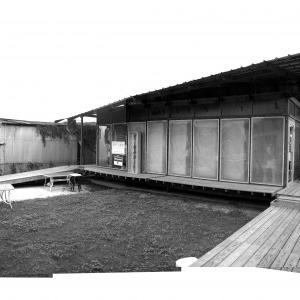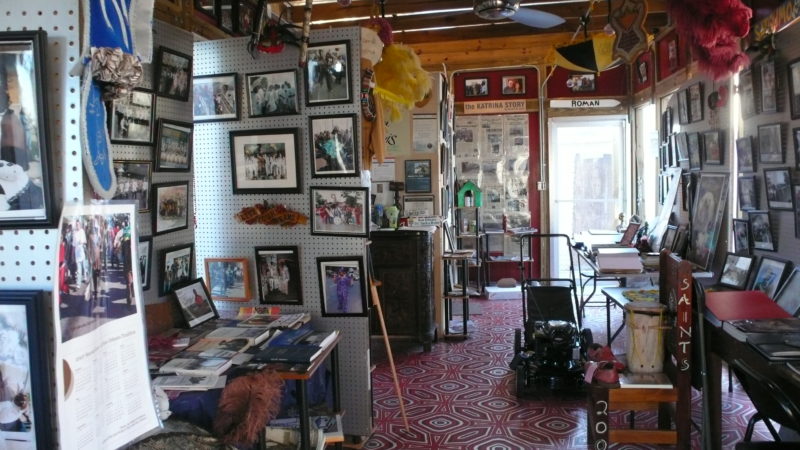
The exterior of the house of Dance and Feathers. photo courtesy of Bethany Rogers
The House of Dance and Feathers is first and foremost a museum displaying the collection of Ronald Lewis’s life. Ronald has a wealth of knowledge on the history, street culture and traditions of the Lower Ninth Ward and New Orleans, and he weaves his personal stories into each artifact in the museum. Ronald encourages a dialogue with his guests, so no two visits to House of Dance & Feathers are ever the same (House of Dance and Feathers, August 16th 2013, “http://houseofdanceandfeathers.org/“).
Though tucked away on Tupelo St., the House of Dance & Feathers is a staple in the community. It began as a backyard shed, barber shop, and gathering place for folks (The Trumpet, March/April 2013, Issue 7 Volume 2.,”culture in the Lower Nine”, page 20). It sits behind a newly painted white house that belongs to Ronald W. Lewis and his wife, Charlotte. Ronald started the museum, dedicated to the culture of Mardi Gras Indians, social and pleasure clubs, and musicians of the neighborhood, before Hurricane Katrina. Its function was a place where young people could come to learn about the culture of their community.

The interior of the House reflects its focus on cultural education. Photo by Bethany Rogers.
Since Katrina, Ronald has become a spokesman for the neighborhood, challenging stereotypes, educating people about his culture, and bridging divides between black and white, resident and visitor, volunteer and survivor. He has helped to resist the misrepresentation that the Lower Nine is a neighborhood of poverty and neglect.
In the summer of 2006, Project Locus, a nonprofit design/build architecture organization, rebuilt Ronald’s home and museum. Students from Kansas State University and others from around the country came to New Orleans to help. In the process, they became close not just with Ronald’s family, but with the other neighbors who had returned home. Since its completion, Ronald continues to keep the doors of the museum open and the people of the Lower Nine continue the slow rebuild.
Ronald Lewis, the Director of the House of Dance and Feathers and President of Big 9 Social and Pleasure Club, said, “But this is me—the collection of artifacts and various conversation pieces that make the House of Dance and Feathers what it is. From the section about the students leaving some of their personal items here to the Mardi Gras Indian beadwork that I done that evacuated with me to an umbrella that was part of the 2006 parade of the Big Nine Social and Pleasure Club to the banner of the original Double Nine Social and Pleasure Club that rose up out the ashes of Sonny’s Bar, this building is a building of many stories.”
Patrick Rhodes, the Architect of the House of Dance and Feathers and Tulane Architecture Professor, said, “The idea was to do something small— simple— that didn’t take away from what was going on around it. But we had to elevate it out of the private realm. We had to make it a public building in some way. We used the roof to express that idea. The roof is the only thing that you really look at. It’s got this big rolling curve and it’s flowing above the building. We wanted to relate it to the idea of water and what the water did.”
LowerNine.org is one of many organizations that have worked to restore the Lower Ninth Ward after Hurricane Katrina. As part of a larger study of the impact and networks of of non-profits in 2013 (please see “Mapping Non-Profit Influence: The Case of the Lower Ninth Ward”: http://www.medianola.org/journal/entry/33/Mapping-Non-Profit-Influence-The-Case-of-the-Lower-9th-Ward for more details), we can see that this organization excels in the following areas:
Performance
1. Access to Consumers regardless of ability to pay
The House of Dance & Feathers is free and open to the public by appointment.
2. Provision of Collective Goods
The House of Dance & Feathers is a collective good, providing education to locals and visitors and preserving the cultural heritage of the Lower Ninth Ward community for all of its residents.
Participation in Information Sharing
When we analyze lowernine.org, based on its extent of participation in information sharing activities, we see they are active in 2 ways.
1. Education
The House of Dance & Feathers is an educational museum, teaching people about the history of Mardi Gras Indians and Social Aid and Pleasure Clubs in New Orleans.
2. Awareness Raising
The museum raises awareness for locals and visitors about the history and culture of New Orleans and specifically the Lower Ninth Ward. The museum hopes to inspire a stronger effort to preserve cultural history in this neighborhood.
 NOLAbeings
Multimedia artist Claire Bangser created NOLAbeings as a portrait-based story project that marries...
NOLAbeings
Multimedia artist Claire Bangser created NOLAbeings as a portrait-based story project that marries...
 Data corner: Adobe Suite (create a PDF, social media graphic, presentation, edit a photo and video
Data corner is where you go to work with analytics and top tech skills. It takes on everything from PERL and SQL to Canva and Sprout Social.
Data corner: Adobe Suite (create a PDF, social media graphic, presentation, edit a photo and video
Data corner is where you go to work with analytics and top tech skills. It takes on everything from PERL and SQL to Canva and Sprout Social.
